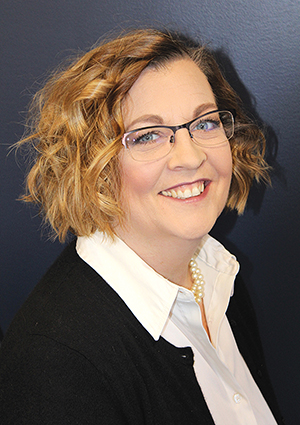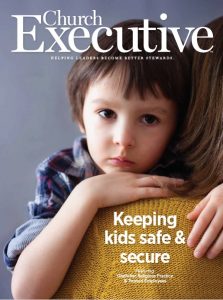
Church Executive spoke with experts in the fields of risk management and background checks about best practices associated with the care of children within the church — and how to equip your staff members with the knowledge they need to enact them.

Vice President
Sales
Trusted Employees
What are the biggest risks and liabilities facing churches in the area of protecting children?
Lori Lord: Predators don’t necessarily look like predators — and that’s the biggest risk. Procedures and policies must be established to keep active predators (who might be actively looking) and impulsive predators (those who might abuse in the moment without having planned to do so) from harming children.
There are also potential legal liabilities regarding negligent selection of church workers and volunteers, negligent supervision of church staff and activities, and even negligent retention of staff.
Plus, any incident involving harm to a child can do irreparable harm to a church’s reputation, which puts membership at great risk.
Elizabeth Norman: The biggest risk is the ever-rotating volunteer base, and the numbers of adults interacting with children at church activities. If one individual slips through the background check process, it can create problems.
Abuse claims are typically one of severity versus frequency. They don’t happen often, but they obviously have life-altering effects on

Director
Risk Control Services
Glatfelter Religious Practices
the victims, as well as the extended church community.
Many churches fall victim to an ‘it-can’t-happen-here’ mentality. What makes churches especially prone to risks related to the care of children?
Norman: An “it-can’t-happen-here” mentality is very dangerous. Statistics show that a predator might have abused many children or vulnerable adults before they are ever discovered. That means even with a good background check process in place, it could still happen in your community.
A good abuse prevention program needs to include policies and procedures that are adhered to and closely monitored, and a vigorous training program for all staff and volunteers.
Lord: Sometimes, churches are prone to several types of risks because resources (financial and personal) are limited.
Additionally, churches might put much trust in their congregations, volunteers and employees — and, unfortunately, some people
take advantage.
Is a written child protection policy something you recommend for churches?
Lord: Absolutely! The first component is a comprehensive background check on anyone who will come in contact with children. History of criminal behavior can be an indicator of potential risk. The policy should outline criminal offenses that are unacceptable (as well as any that might be acceptable).
There should always be two people in a room with children to prevent any opportunities where a child is alone with one person.
Additionally, the policy should outline how behavior will be monitored and what the potential consequences will be for failure to abide by the rules set forth by the policy.
Norman: We promote a strong written child protection policy as the backbone of a Child Protection Program. That program should include at a minimum:
• Employee and volunteer screening and selection procedures
• Supervision of youth policies (example: no adult alone with a child)
• Reporting procedures
• Training and education for all staff / volunteers who work with children
What does a comprehensive screening and background check process look like as it relates to protecting children in the church?
Norman: State and national sex offender registry checks and criminal background checks are both important. Requiring at least three references, including at least

one family member, is also important. The thought process behind having a family member provide a reference is that they might be more aware of any behavior issues.
References need to be contacted directly and their feedback thoroughly documented.
Lord: First and foremost, don’t let cost be the driver. Make sure you’re working with a credible partner. This ensures access to a full line of services; that the information is reliable and accurate; that everything you do in the process is legal and complies with state and local laws; that the process is done quickly and efficiently; and that the applicant’s sensitive data is handled securely. Obviously, comprehensive sex offender registry searches are crucial, so make sure that your background screening partner will check and provide those details from all 50 states. It’s important to ask, because some background check companies do not, by default, check all states. Ask ahead of time to be sure.
To better understand abuse reporting requirements in your state, visit childwelfare.gov for a 50-state guide.
For the components of a truly comprehensive background check, download the Keeping kids safe & secure eBook at churchexecutive.com/ebooks#risk-management for our recommendations, from criminal records history to education verification.
Do your recommendations for screening and background check processes differ depending on whether the individual being vetted is a staff member or volunteer?
Lord: The actual process for screening and background checks shouldn’t be different — the components of the screen could be. You might not need to check credit, educational or employment verifications on a volunteer, but you should check them for some staff members. The key is to be consistent and to actually conduct the background checks on both staff members and volunteers.
Also, re-screening both staff and volunteers is a best practice to minimize risk.
Norman: The processes should not differ between an individual being vetted as a staff member or volunteer.
What recommendations can you offer regarding the child check-in / check-out processes at a church?
Norman: In areas where youth activities occur — where classes and other activities take place — consider windows in doors and / or wall panels, concave mirrors in hallways to view blind spots, and windows to visualize outdoor play spaces. If infant care is provided, diapering areas should only be separated from activity rooms by either half-walls or walls with glass to increase visibility of caregivers and children during diapering.
Check-in and check-out procedures can differ for older children at faith formation activities, but it’s advisable that strict sign-in and sign-out procedures be followed for preschool-aged children, whether during a daycare program or a ministry activity.
Lord: Ensure that parents and guardians are required to formally check a child into any church activity, and only release a child directly to the parent or guardian who brought them. If another adult will be dropping off or picking up, that adult should have written authorization from the child’s parent or guardian.
Lock or prevent unauthorized access to areas that won’t be used for a church event. Having windows in areas that will be used creates more visibility and makes supervision easier.
Consistency in all check-in / check-out procedures is the best policy.
What if a child in the church’s care reports abuse in the home?
Lord: In many states, both employees and volunteers working with children are considered “mandated reporters,” meaning they have a legal obligation to report suspicion of child abuse or neglect to the authorities.
One mistake is failure to report immediately out of respect for the accused. Anyone can be an abuser, no matter their appearance, occupation or involvement with a religious organization — and it’s always best to alert authorities when a child could be at risk.
Norman: As part of the abuse prevention training, staff and volunteers should be informed of the specific reporting requirements for their state and / or jurisdiction.
The biggest mistake made in these situations is when such a report isn’t taken seriously, and even perhaps minimized, because the parents are known to staff / volunteers and they find it hard to believe the child’s story.
Each and every report should be taken seriously and followed up on by someone on the leadership team.
— Reporting by Joyce Guzowski


